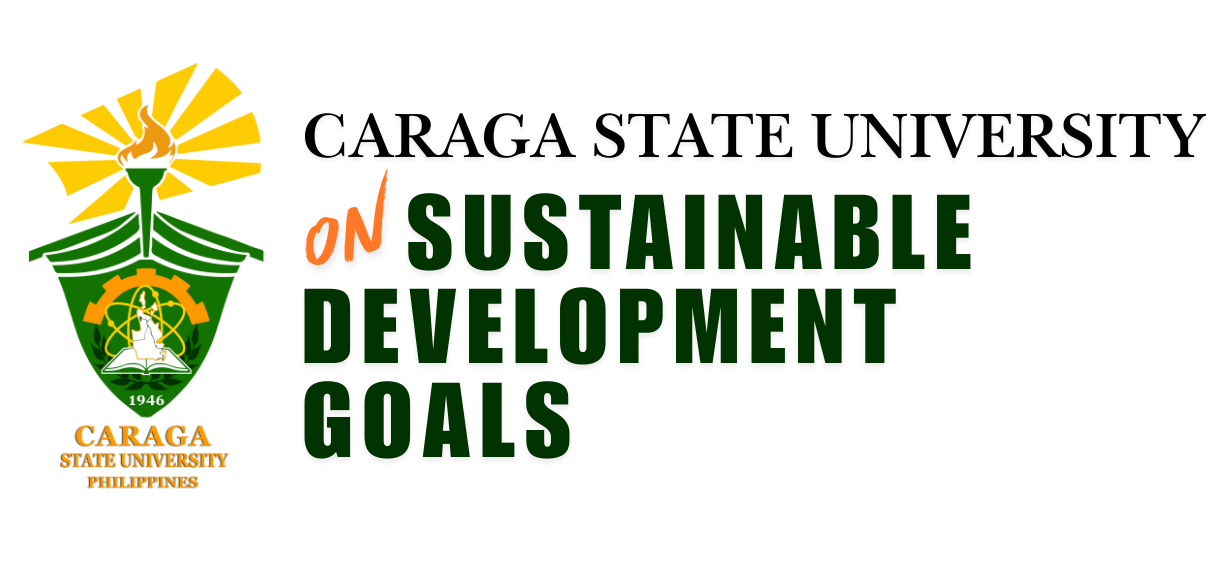CSU’s Scopus Performance
Caraga State University’s Scopus-Indexed Research Publications Reach an All-Time High
Caraga State University (CSU) continues to expand its research footprint, as evidenced by its all-time publication performance in Scopus. As of the latest data, CSU researchers have collectively contributed 657 scholarly works since 2010, authored by 662 scholars, showcasing the university’s dedication to advancing knowledge across various disciplines.
Based on the latest SciVal data covering the years 2021 to 2025, Caraga State University (CSU) ranks 10th nationwide among Philippine academic institutions in terms of Scopus-indexed scholarly output, with a total of 440 publications produced by 584 researchers. SciVal is an advanced analytics solution, built on a core of Scopus® data, that enables the flexible evaluation of any research field as well as the research performance of individuals, research groups, departments, institutions, and countries.
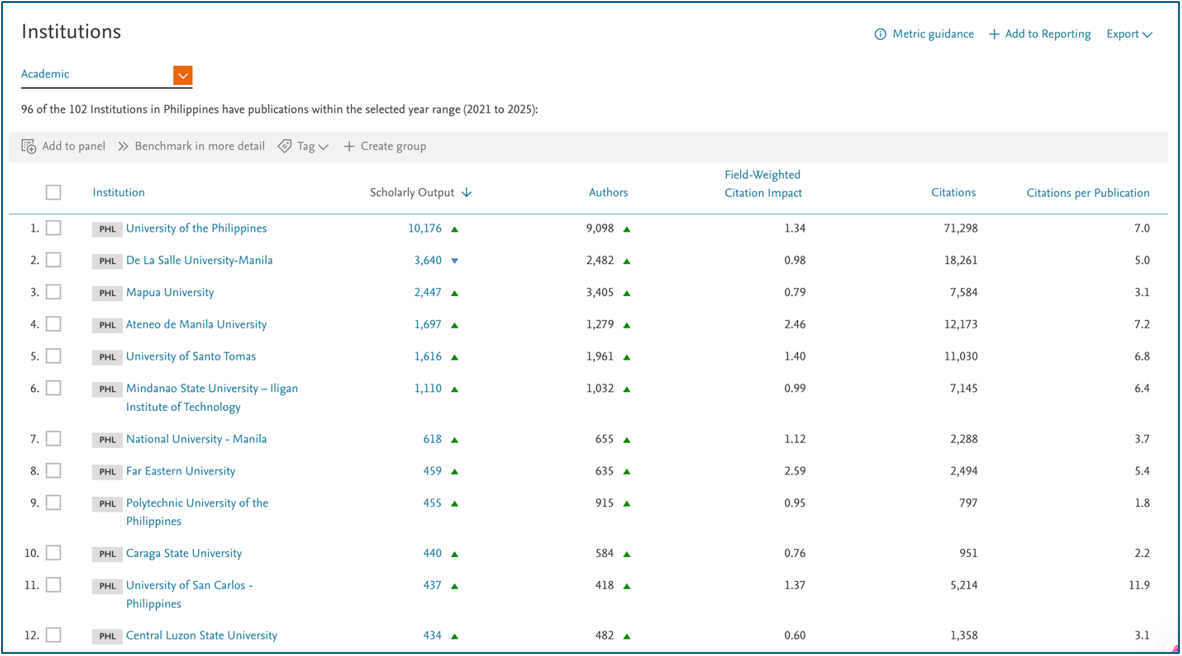
The five-year span (2021–2025) is a critical metric in research analytics as it captures sustained scholarly productivity and impact, allowing for the identification of emerging trends, consistent performers, and areas needing support.
Despite being a relatively young institution in the national research ecosystem, CSU’s performance over this period highlights its accelerating contributions to global scholarship, particularly in multidisciplinary fields, and positions it among the country’s leading academic institutions in research.
In 2024 alone, CSU achieved a remarkable milestone, with 244 research articles accepted and published in Scopus-indexed journals and conference proceedings. While the indexing process takes time, 168 of these publications have already been indexed, further reinforcing CSU’s growing research influence on a global scale. This surge in research output highlights the university’s commitment to fostering a culture of innovation and scholarly excellence.
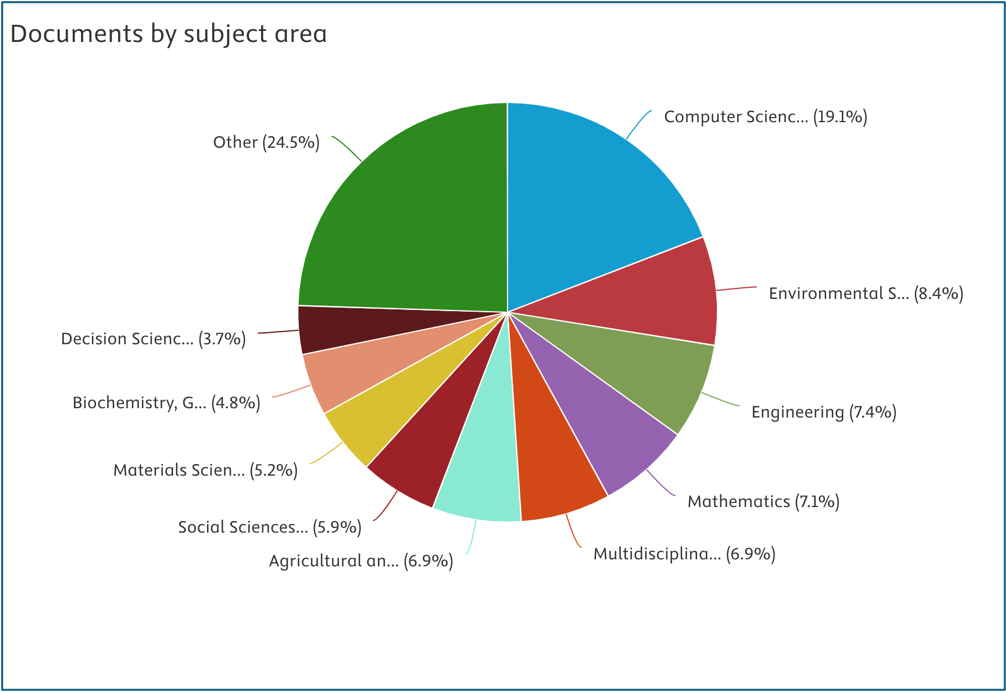
The chart above illustrates the distribution of documents by subject area based on CSU’s Scopus performance report. Key observations include:
- The largest category is “Other” (24.5%), indicating that a substantial portion of research output falls outside the predefined subject classifications.
- Computer Science (19.1%) is the most represented specific discipline, highlighting CSU’s strong research presence in this field.
- Other notable subject areas include:
- Environmental Science (8.4%)
- Engineering (7.4%)
- Mathematics (7.1%)
- Multidisciplinary Research (6.9%)
- Agricultural and Biological Sciences (6.9%)
- Social Sciences (5.9%)
- Materials Science (5.2%)
- Biochemistry, Genetics, and Molecular Biology (4.8%)
- Decision Sciences (3.7%)
This distribution reflects CSU’s diverse research portfolio, with notable strengths in Computer Science, Environmental Science, and Engineering. Meanwhile, Social Sciences and Decision Sciences have a comparatively smaller share, suggesting potential areas for further development.
Productivity and Impact (2021-2025), according to SciVal
| Areas | Scholarly Output | Citations | Authors | Field-Weighted Citation Impact |
| Computer Science | 146 ↓ | 167 | 230 ↑ | 0.51 |
| Multidisciplinary / Intedisciplinary | 84 ↑ | 102 | 190 ↑ | 1.61 |
| Mathematics | 75 ↓ | 75 | 135 ↓ | 0.57 |
| Engineering | 73 ↓ | 196 | 130 ↓ | 0.8 |
| Environmental Science | 72 ↓ | 218 | 121 ↓ | 0.55 |
| Agricultural and Biological Sciences | 63 ↓ | 147 | 107 ↓ | 0.34 |
| Social Sciences | 60 ↑ | 65 | 118 ↑ | 0.46 |
| Biochemistry, Genetics and Molecular Biology | 49 ↑ | 56 | 51 ↑ | 0.19 |
| Decision Sciences | 44 ↓ | 43 | 85 ↑ | 0.54 |
| Materials Science | 44 ↑ | 128 | 61 ↑ | 0.55 |
| Chemical Engineering | 41 ↑ | 46 | 41 ↑ | 0.2 |
| Medicine | 38 ↑ | 133 | 81 ↑ | 0.78 |
| Energy | 35 ↓ | 105 | 58 ↓ | 0.81 |
| Chemistry | 33 ↑ | 56 | 23 ↑ | 0.24 |
| Physics and Astronomy | 31 ↓ | 33 | 57 ↓ | 0.85 |
| Earth and Planetary Sciences | 23 ↓ | 69 | 39 ↓ | 0.95 |
| Business, Management and Accounting | 17 ↓ | 73 | 35 ↑ | 0.8 |
| Economics, Econometrics and Finance | 10 ↑ | 30 | 27 ↑ | 1.16 |
| Psychology | 10 ↑ | 26 | 19 ↑ | 0.64 |
| Arts and Humanities | 9 ↑ | 28 | 15 ↑ | 0.84 |
| Immunology and Microbiology | 7 ↑ | 73 | 6 ↑ | 1.89 |
| Pharmacology, Toxicology and Pharmaceutics | 4 ↑ | 20 | 12 ↑ | 0.91 |
| Nursing | 2 ↑ | 8 | 5 ↑ | 1.26 |
The research productivity and impact of Caraga State University (CSU) span multiple disciplines, with varying trends in scholarly output, citations, and author participation. Across all subject areas, from 2021 to 2025, CSU has produced 440 scholarly outputs, receiving 951 citations from 584 authors, with a Field-Weighted Citation Impact (FWCI) of 0.76, indicating a citation rate slightly below the global average.
Growth Areas
Several disciplines have shown an upward trend in research activity and impact. The Multidisciplinary field leads with an FWCI of 1.61, demonstrating a strong research influence relative to global standards. Immunology and Microbiology also stands out with an FWCI of 1.89, despite having only seven scholarly outputs, indicating high citation impact. Economics, Econometrics, and Finance (FWCI: 1.16) and Nursing (FWCI: 1.26) also reflect strong influence despite their smaller scholarly output. Meanwhile, Medicine (38 outputs, 133 citations) and Materials Science (44 outputs, 128 citations) are emerging areas of interest, showing both growth in output and citations.
Declining Fields
Some disciplines have seen a decrease in output and citation performance. Computer Science, despite its 146 scholarly outputs, has an FWCI of 0.51, suggesting that its research impact is below the global average. Similarly, Engineering (FWCI: 0.80), Environmental Science (FWCI: 0.55), and Agricultural and Biological Sciences (FWCI: 0.34) have all experienced declines in scholarly output, citations, and author contributions. Mathematics, with 75 outputs and 75 citations, also saw a decrease in research activity, with an FWCI of 0.57.
Emerging and Niche Fields
Certain subject areas, while having relatively low research output, are showing potential. Arts and Humanities, Psychology, and Pharmacology, Toxicology, and Pharmaceutics all experienced growth in output and citations, signaling increasing research engagement. Earth and Planetary Sciences has a moderate FWCI of 0.95, indicating its citation performance is near the global average.
| Publication Year | Document Title | Authors | Journal | Citations from 2020-2024 (Last 5-Years) | Rank |
|---|---|---|---|---|---|
| 2019 | A system for monitoring water quality in a large aquatic area using wireless sensor network technology | Demetillo, Alexander T.; Japitana, Michelle V.; Taboada, Evelyn B. | Sustainable Environment Research | 123 | 1 |
| 2020 | Applications of imaging and spectroscopy techniques for non-destructive quality evaluation of potatoes and sweet potatoes: A review | Sanchez, Philip Donald C.; Hashim, Norhashila; Shamsudin, Rosnah; Mohd Nor, Mohd Zuhair | Trends in Food Science and Technology | 88 | 2 |
| 2016 | Vertical accuracy assessment of 30-M resolution ALOS, ASTER, and SRTM global DEMS over Northeastern Mindanao, Philippines | Santillan J.R.; Makinano-Santillan M. | International Archives of the Photogrammetry, Remote Sensing and Spatial Information Sciences - ISPRS Archives | 86 | 3 |
| 2020 | Accounting for symptomatic and asymptomatic in a SEIR-type model of COVID-19 | Arcede, Jayrold P.; Caga-Anan, Randy L.; Mentuda, Cheryl Q.; Mammeri, Youcef | Mathematical Modelling of Natural Phenomena | 43 | 4 |
| 2017 | Development of gallic acid-modified hydrogels using interpenetrating chitosan network and evaluation of their antioxidant activity | Kang, Byungman; Vales, Temmy Pegarro; Cho, Byoung-Ki; Kim, Jong-Ki; Kim, Ho-Joong | Molecules | 41 | 5 |
| 2021 | Cloud Computing Adoption Intention by MSMEs in the Philippines | Matias, Junrie B.; Hernandez, Alexander A. | Global Business Review | 35 | 6 |
| 2023 | In-depth study of tomato and weed viromes reveals undiscovered plant virus diversity in an agroecosystem | Rivarez, Mark Paul Selda, et al. | Microbiome | 33 | 7 |
| 2022 | Emerging nondestructive techniques for the quality and safety evaluation of pork and beef: Recent advances, challenges, and future perspectives | Sanchez, Philip Donald C., et al. | Applied Food Research | 31 | 8 |
| 2018 | Tools for circular economy: Review and some potential applications for the Philippine textile industry | Balanay, Raquel; Halog, Anthony | Circular Economy in Textiles and Apparel: Processing, Manufacturing, and Design | 31 | 8 |
| 2021 | Circular Economy across Australia: Taking Stock of Progress and Lessons | Anthony Halog, Raquel Balanay, Sandra Anieke & Tsz Yan Yu | Circular Economy and Sustainability | 30 | 9 |
| 2018 | Glycoproteomic Alterations in Drug-Resistant Nonsmall Cell Lung Cancer Cells Revealed by Lectin Magnetic Nanoprobe-Based Mass Spectrometry | Juanilita T. Waniwan; Yi-Ju Chen; Rey Capangpangan; Shao-Hsing Weng; Yu-Ju Chen | Journal of Proteome Research | 30 | 9 |
| 2021 | Impact of vaccine supplies and delays on optimal control of the COVID-19 pandemic: mapping interventions for the Philippines | Carlo Delfin S. Estadilla, Joshua Uyheng, Elvira P. de Lara-Tuprio, Timothy Robin Teng, Jay Michael R. Macalalag, Maria Regina | Infectious Diseases of Poverty | 25 | 10 |
| 2020 | Development of poly (2-Methacryloyloxyethyl Phosphorylcholine)-functionalized hydrogels for reducing protein and bacterial adsorption | Temmy Pegarro Vales; Jun-Pil Jee; Won Young Lee; Sung Cho; Gye Myung Lee; Ho-Joong Kim; Jung Suk Kim | Materials | 25 | 10 |
Notable Trends in Research Output
- COVID-19-related research has also gained significant attention, such as:
o SEIR-type modeling for symptomatic and asymptomatic COVID-19 cases (43 citations)
o Impact of vaccine supplies and delays on pandemic control in the Philippines (25 citations) - Emerging research areas include Circular Economy, Cloud Computing Adoption, Viromes in Agroecosystems, and Nondestructive Food Quality Evaluation with growing citation counts.
Key Observations on Citation Impact
- The highest-ranked paper (2019) has 123 citations, reflecting strong engagement in environmental and sensor-based research.
- Papers from 2020-2021 show substantial citations, indicating their relevance and impact in the last five years.
- Multidisciplinary research areas such as food science, materials science, environmental monitoring, and mathematical modeling are gaining traction.
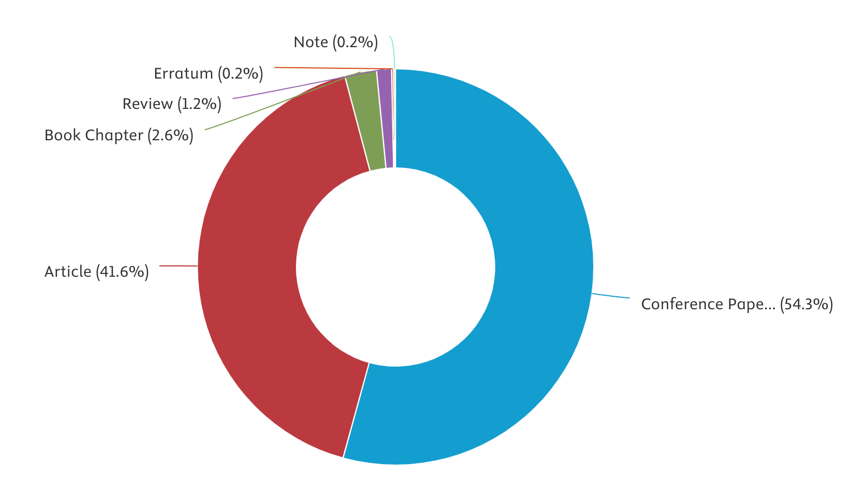
The chart provides an overview of the distribution of research output by document type based on CSU’s Scopus performance report. This breakdown highlights the preferred avenues for academic dissemination among CSU researchers.
Key Takeaways:
- Conference Papers (54.3%) represent the largest share, indicating that a significant portion of research findings is presented at conferences rather than published in journals.
- Journal Articles (41.6%) make up a substantial portion, showcasing CSU’s strong engagement in peer-reviewed scholarly publishing.
- Other document types contribute to a smaller share of total research output, including:
- Book Chapters (2.6%)
- Reviews (1.2%)
- Errata (0.2%)
- Notes (0.2%)
This distribution suggests that CSU researchers heavily rely on conference proceedings for academic dissemination, which facilitates rapid knowledge sharing and networking opportunities. However, increasing the proportion of journal articles may enhance the citation impact and long-term visibility of research output.
Below are the top contributors per area (Source: Scopus):
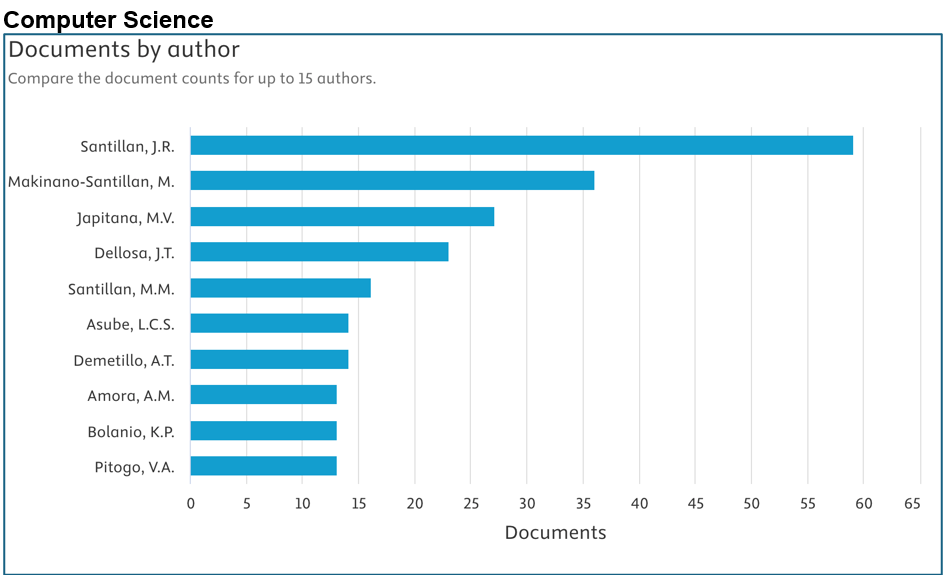
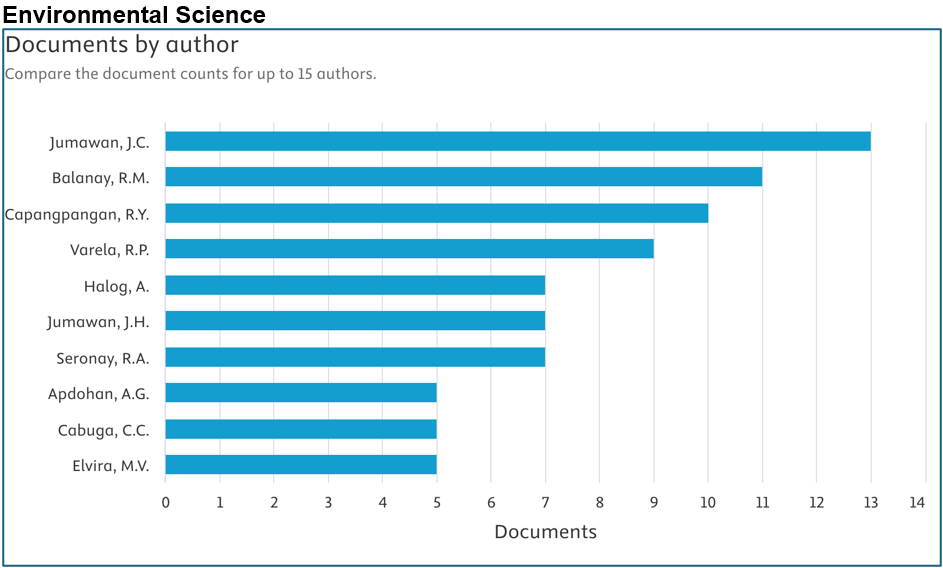
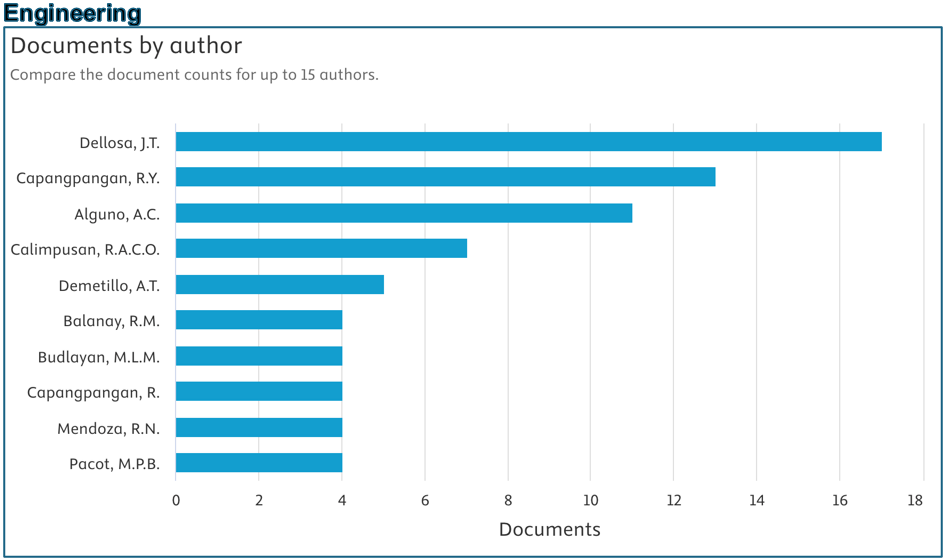
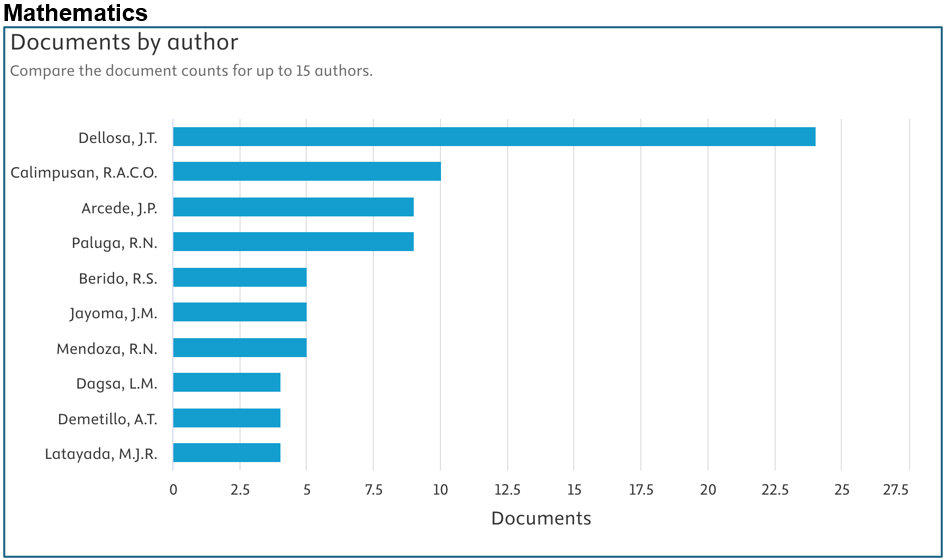
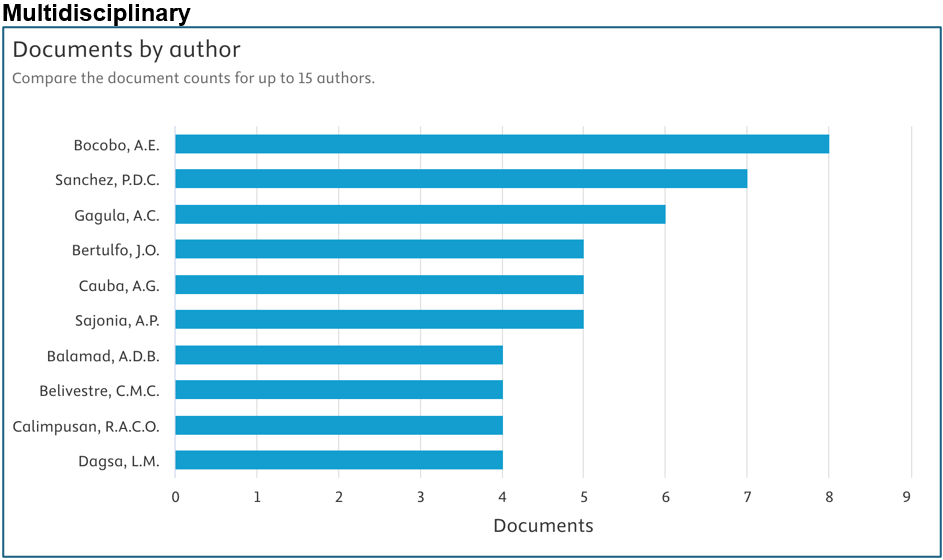
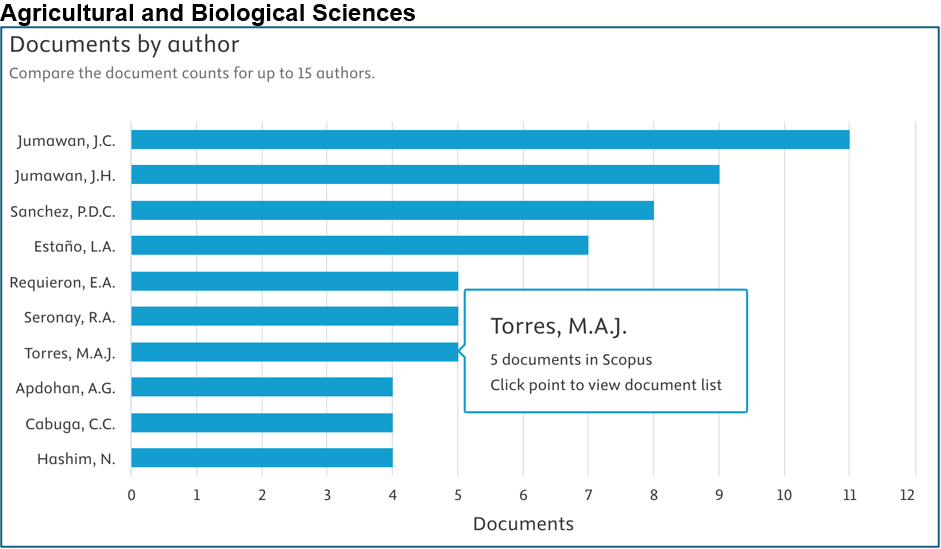
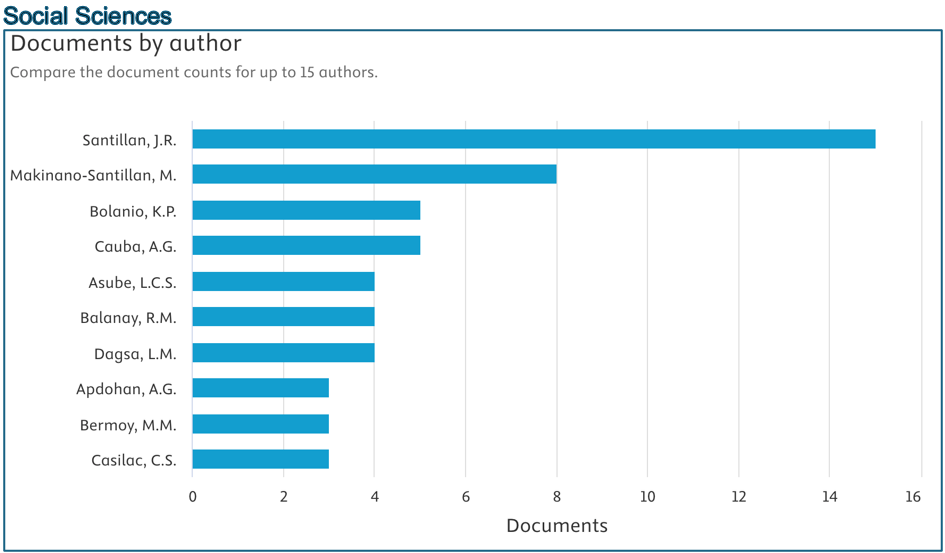
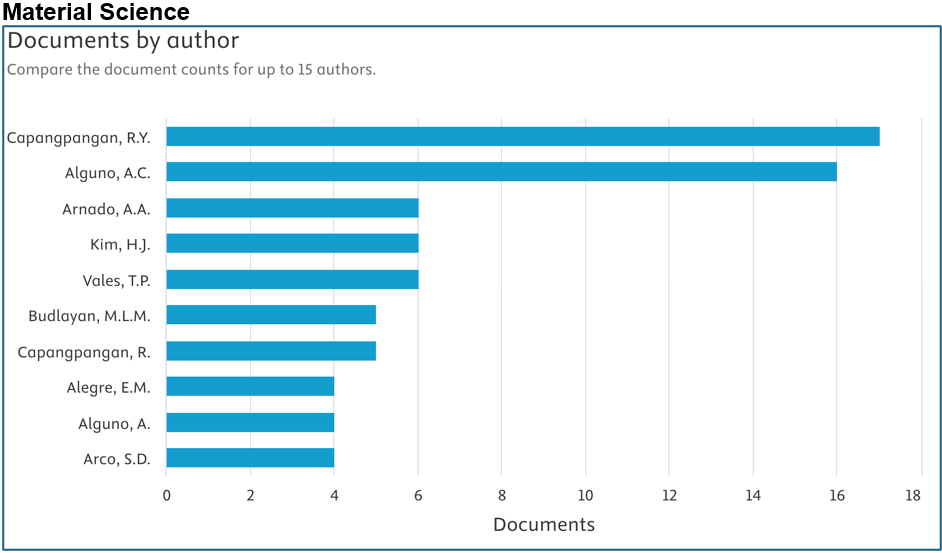
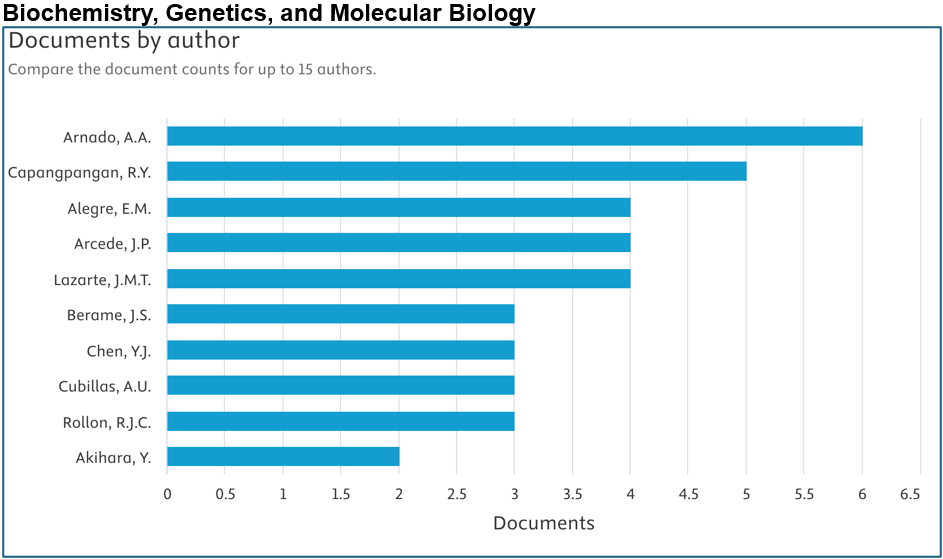
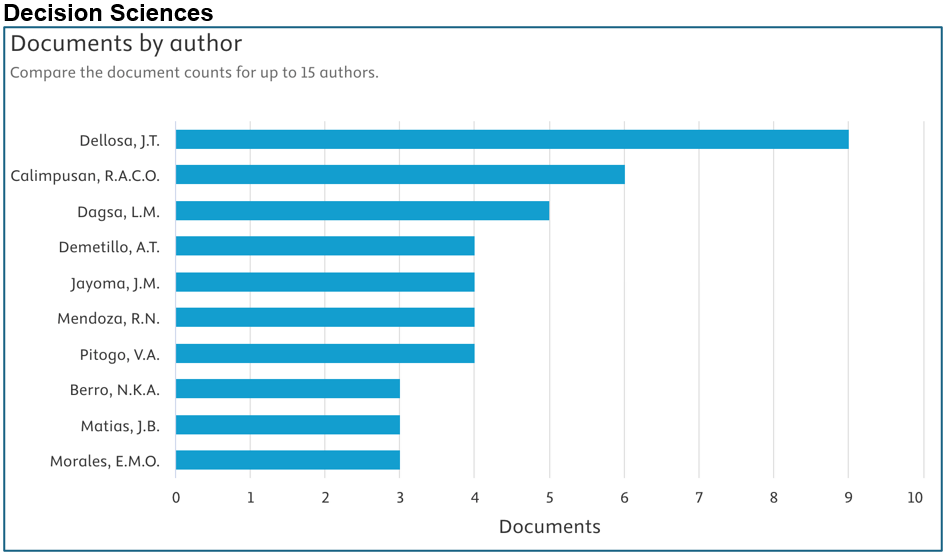

Prepared by: Dr. Junrie B. Matias, RDIE Publication Management Office Director
